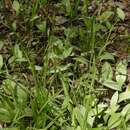Description
provided by eFloras
Culms densely tufted, ascending, lax or, occasionally, decumbent, 12–44 cm × 0.7–1.2 mm. Leaves: basal sheaths brown; sheaths 3–24 mm, serrulate; blades ascending, midrib well developed abaxially, lateral veins developed, flat, 10–32 cm × 3–10 mm, blades of overwintering leaves smooth. Inflorescences: peduncles of proximal spike 0–8 cm, distal lateral spike not exserted; of terminal spike to 0.2 cm. Bracts 10–30 × 2–7 mm, 2d pistillate bract frequently overtops terminal and distal lateral spike, blade of distal lateral spike linear, narrower than spikes, widest bract blade of distalmost lateral spike 0.5–3.4 mm wide. Spikes 4(–5) per culm; lateral spikes 9–22 × 2.8–4 mm; terminal spike linear, 7–16 × 1.2–2 mm, arising from same bract as distal lateral spike, usually surpassed by distal bract. Pistillate scales 2–2.5 × 1–1.8 mm, apex acute or apiculate. Staminate scales ovate, 2.2–2.6 × 0.8–1 mm, margins hyaline or slightly brown tinged, apex acute. Anthers 1.6–2 mm. Perigynia 5–14 per spike, overlapping or slightly scattered on proximal spike, ascending or spreading, 8–18-veined, 2–3 veins conspicuous, others obscure, elliptic-obovate, 2.2–3.2 × 1–1.5 mm, membranous; beak abruptly to slightly curved, 0.3–1.1 mm. Achenes obovoid, 1.8–2.8 × 0.8–1.2 mm. 2n = 36.
- license
- cc-by-nc-sa-3.0
- copyright
- Missouri Botanical Garden, 4344 Shaw Boulevard, St. Louis, MO, 63110 USA
Distribution
provided by eFloras
N.B., Nfld. and Labr., N.S., Ont., P.E.I., Que.; Conn., Del., Ind., Ky., Maine, Md., Mass., Mich., Minn., N.H., N.J., N.Y., N.C., Ohio, Pa., R.I., S.C., Tenn., Vt., Va., W.Va., Wis.
- license
- cc-by-nc-sa-3.0
- copyright
- Missouri Botanical Garden, 4344 Shaw Boulevard, St. Louis, MO, 63110 USA
Habitat
provided by eFloras
Moist to wet deciduous, evergreen, or mixed deciduous-evergreen forests, higher elevations southward; 0–1800m.
- license
- cc-by-nc-sa-3.0
- copyright
- Missouri Botanical Garden, 4344 Shaw Boulevard, St. Louis, MO, 63110 USA
Synonym
provided by eFloras
Carex laxiflora Lamarck var. leptonervia Fernald, Rhodora 8: 184 1906
- license
- cc-by-nc-sa-3.0
- copyright
- Missouri Botanical Garden, 4344 Shaw Boulevard, St. Louis, MO, 63110 USA
Comprehensive Description
provided by North American Flora
Carex leptonervia Fernald, Rhodora 16: 214. 1914
"Carex laxiflora var. intermedia Boott" L. H. Bailey; Arth. Bull. Geol. Nat. Hist. Surv. Minn. 3:
22. 1887. (Minnesota; see Wiegand, Rhodora 24: 201.) Carex laxiflora var. varians L. H. Bailey, Mem. Torrey Club 1 : 32. 1889. (In large part; type from
Minnesota. See Wiegand, Rhodora 24: 201. 1922.) regarded by me as publication. Carex laxiflora var. leptonervia Fernald, Rhodora 8 : 184. 1906. (Type from Fort Fairfield, Maine.) Carex blanda var. varians Burnham, Torreya 19: 133. 1919. (Based on C. laxiflora var. varians
L. H. Bailey.)
Cespitose, the rootstocks slender, the culms 1.5-7 dm. high, mostly lateral and aphyllopodic, evenly leafy, weakly erect or decumbent, sharply triangular but not winged, the angles minutely serrulate, exceeding the leaves, brownish at base; sterile shoots elongate, conspicuous; leaf-blades deep-green, flat, flaccid, 1-3.5 dm. long, 3-10 mm. wide, roughened towards the apex on the margins, the midvein prominent on the lower surface and the two mid-lateral veins on the upper, the sheaths enlarged upward, strongly retrorsely serrulate towards the mouth, short-prolonged upward beyond base and continuous with the long conspicuous ligule; staminate spike narrowly linear, sessile or nearly so, 1-2.5 cm. long, 2 mm. wide, the scales oblong-obovate, mucronate, white-hyaline with green, scabrous, 3-nerved center; pistillate spikes 2-4, the upper 1 or 2 and the staminate approximate, sessile or short-exsert-peduncled, the lower 1 or 2 more or less strongly separate, exsert-peduncled, linear, 1-3 cm. long, 3-4 mm. wide, loosely 10-20-flowered in few rows, the perigynia erect-ascending, the peduncles rough, somewhat ancipital; bracts long-sheathing, the sheath-margins strongly serrulate, the upper blades at least exceeding the culm; scales oblong-obovate, mucronate to obtuse, about width of but much shorter than the perigynia, white-hyaline and more or less strongly brownishtinged, with conspicuous 3-nerved green center; perigynia elliptic-obovoid, not at all inflated, obtusely triangular below, more sharply so above, 3.5-4.5 mm. long, 1.5 mm. wide, deep-green or in age light-green, membranaceous, glandular-puncticulate, 2-ribbed, otherwise nerveless or faintly nerved, stipitate, long-tapering and spongy at base, contracted into a short, straight or oblique beak 0.5 mm. long, with entire oblique orifice; achenes obovoid, filling perigyniumbody, sharply triangular with concave sides, 2 mm. long, 1.5 mm. wide, brownish, granular, substipitate, short-apiculate, jointed with the short slender style; stigmas three, reddish-brown, slender; anthers 1.5 mm. long.
Type locality (of C. laxiflora var. leptonervia on which C. leptonervia is based) : Ft. Fairfield, Maine (Fernald 146).
Distribution: In woodlands, Newfoundland to Minnesota, and southward to northern New Jersey and Ohio, and in the mountains to North Carolina and Tennessee. (Specimens examined from Newfoundland, Quebec, Nova Scotia, Prince Edward Island, New Brunswick, Maine, New Hampshire, Vermont, Massachusetts, Connecticut, New York, New Jersey, Pennsylvania, Virginia, North Carolina, Tennessee, Ohio, Ontario, Michigan, Wisconsin, Minnesota.)
- bibliographic citation
- Kenneth Kent Mackenzie. 1935. (POALES); CYPERACEAE; CARICEAE. North American flora. vol 18(5). New York Botanical Garden, New York, NY
Carex leptonervia: Brief Summary
provided by wikipedia EN
Carex leptonervia, also known as nerveless woodland sedge, is a species of flowering plant in the sedge family, Cyperaceae. It is native to Eastern Canada and the United States.
- license
- cc-by-sa-3.0
- copyright
- Wikipedia authors and editors

